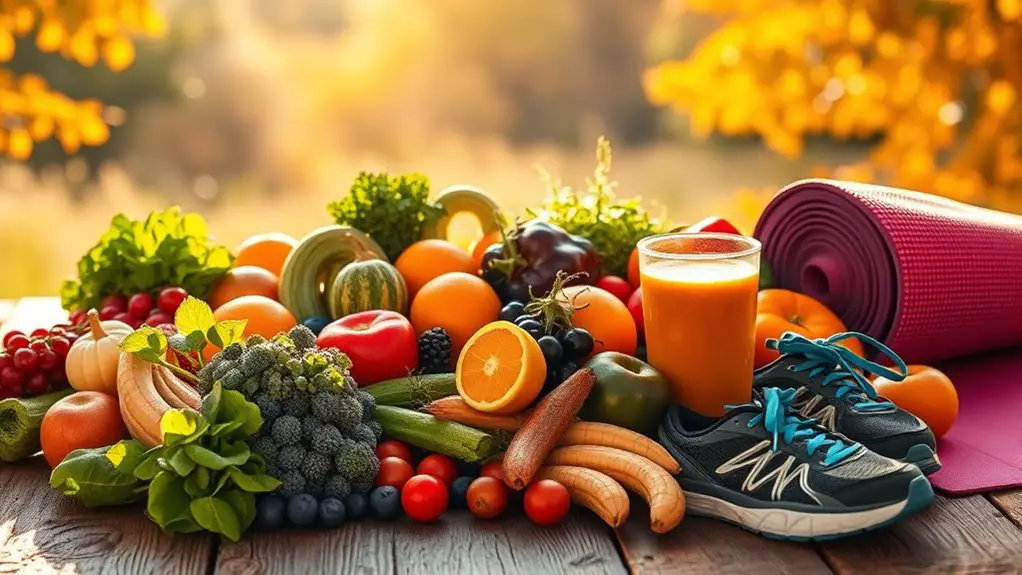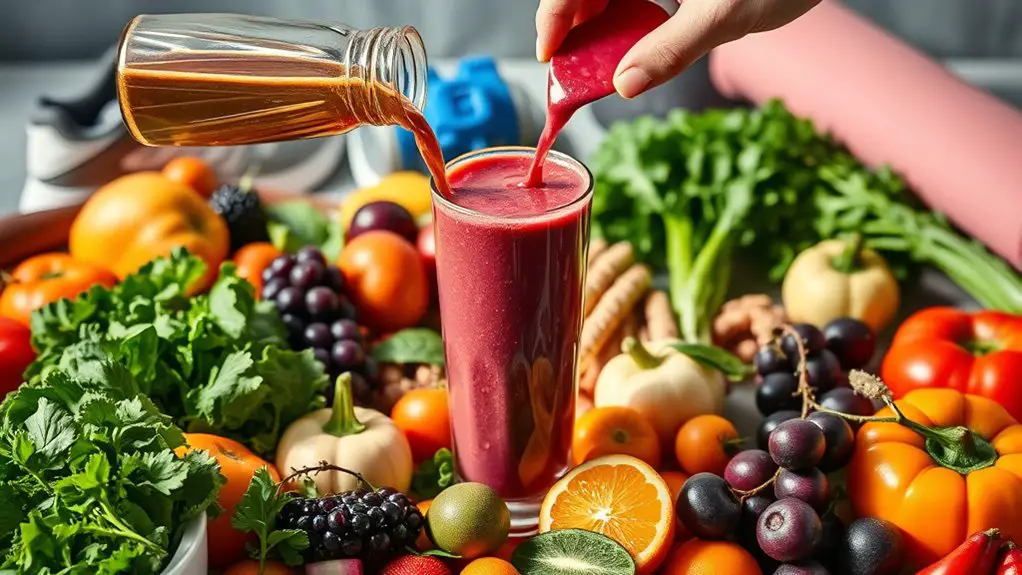How to Adjust Your Diet for Seasonal Training Goals

To adjust your diet for seasonal training goals, focus on incorporating nutrient-dense foods aligned with each season’s needs. In winter, opt for warming, protein-rich meals like lean meats and citrus for antioxidants. Spring calls for leafy greens and asparagus, while summer demands hydration with fruits like watermelon. In fall, lean on fiber and omega-3s from pumpkins and apples. Adapting your nutrition not only supports performance but also aids recovery, and there’s more to discover about seasonal eating benefits.
Understanding Your Body’s Seasonal Needs

When you consider how your body responds to different seasons, you’ll notice that your nutritional needs can shift considerably. In winter, for instance, your body temperature drops, prompting a need for more warming, nutrient-dense foods that can help maintain energy levels. You might find that your energy fluctuations are more pronounced during colder months, requiring you to adjust your carbohydrate intake to fuel your workouts effectively.
In contrast, summer often brings higher temperatures, which can impact your hydration and energy requirements. You may need lighter meals focused on hydration, like fruits and vegetables, to keep your body cool and energized. Paying attention to how these seasonal changes affect your body helps you make better dietary choices. By being mindful of these shifts, you can guarantee your nutrition supports your training goals, optimizing performance and recovery throughout the year.
Key Nutrients for Different Training Seasons
As you shift your training focus with the seasons, it’s essential to understand which key nutrients can enhance your performance and recovery. Different seasonal foods provide unique benefits, and practicing nutrient timing can maximize these effects. Here’s a breakdown of essential nutrients for each season:
| Season | Key Nutrients | Seasonal Foods |
|---|---|---|
| Spring | Vitamins A, C, E | Asparagus, Strawberries |
| Summer | Electrolytes, Carbs | Watermelon, Corn |
| Fall | Fiber, Omega-3s | Pumpkins, Apples |
| Winter | Protein, Antioxidants | Kale, Citrus Fruits |
| Year-round | Hydration, Complex Carbs | Quinoa, Sweet Potatoes |
Incorporating these foods into your diet can help meet your training goals effectively. Remember, aligning your nutrient intake with your training seasons will support peak performance and recovery.
Meal Planning for Optimal Performance

Understanding the key nutrients for each season sets the foundation for effective meal planning that aligns with your training goals. To optimize your performance, focus on meal prep that incorporates seasonal ingredients. Here’s a quick guide:
Seasonal ingredients play a crucial role in meal planning, enhancing performance and supporting training goals throughout the year.
- Spring: Load up on leafy greens and asparagus for vitamins and minerals that support energy levels.
- Summer: Embrace berries and tomatoes, which are high in antioxidants to combat heat stress and inflammation.
- Fall: Incorporate squash and apples, rich in complex carbs and fiber, to fuel your workouts as temperatures drop.
- Winter: Choose root vegetables and citrus fruits for hearty nutrition and immune support during colder months.
Hydration Strategies Year-Round
Hydration doesn’t just matter during workouts; it’s vital year-round to maintain peak performance and overall health. To optimize your hydration, focus on diverse hydration sources. Water’s your best friend, but you can also benefit from fruits, veggies, and electrolyte drinks, especially during intense training sessions.
Fluid timing is essential, too. Aim to hydrate consistently throughout the day rather than chugging large amounts at once. Start your morning with a glass of water, and keep a bottle handy during the day. During workouts, drink about 7-10 ounces every 10-20 minutes, adjusting for sweat loss and environmental conditions.
Post-exercise, replenish fluids to support recovery. If you’ve been sweating heavily, consider adding electrolytes to your post-workout drink to rehydrate effectively. By incorporating these strategies, you’ll help your body perform at its best, regardless of the season.
Adapting Your Nutrition for Recovery and Injury Prevention

While it’s easy to overlook nutrition during recovery, what you eat plays an essential role in preventing injuries and promoting healing. Incorporating specific recovery foods can make a significant difference in your training regimen. Here are four key nutrients to focus on:
- Protein: Supports muscle repair. Include lean meats, fish, or plant-based proteins.
- Omega-3 Fatty Acids: Reduces inflammation. Think fatty fish, flaxseeds, or walnuts.
- Antioxidants: Combat oxidative stress. Load up on berries, dark chocolate, and leafy greens.
- Complex Carbohydrates: Replenish glycogen stores. Opt for whole grains, sweet potatoes, and legumes.
Frequently Asked Questions
How Can I Maintain Motivation While Adjusting My Diet Seasonally?
Sticking to your diet during seasonal changes can feel like a rollercoaster. You’re not alone in facing diet challenges, but maintaining seasonal motivation’s key. Start by setting small, achievable goals that align with the changing seasons. Celebrate your progress, no matter how minor. Incorporate seasonal foods to keep meals fresh and exciting. Remember, it’s all about balance; allowing occasional treats can make the process enjoyable and sustainable. You’ve got this!
What Are the Best Snacks to Support Seasonal Training?
When you’re looking for the best snacks to support your seasonal training, focus on nutrient timing and energy density. Opt for snacks like Greek yogurt with fruit, which provide protein and carbohydrates for recovery. Nut butter on whole-grain toast offers healthy fats and sustained energy. Snack on trail mix with nuts and dried fruits for a quick boost. These options help fuel your workouts and keep your energy levels steady throughout the seasons.
How Can I Track My Dietary Changes Effectively?
To track your dietary changes effectively, consider using diet journals or food apps. Journals allow you to jot down meals, snacks, and feelings about your food choices, which can help identify patterns. Food apps, on the other hand, offer features like barcode scanning and nutritional analysis, making it easier to log your intake accurately. Whichever method you choose, consistency’s key to understanding how your diet impacts your overall health and performance.
What Are Common Mistakes to Avoid When Changing My Diet?
Imagine trying to balance on a seesaw with a friend, but one of you is much heavier. That’s what happens when you face caloric miscalculations and nutrient imbalances in your diet. You might think cutting calories is enough, but it can lead to fatigue and poor performance. Instead, focus on whole foods and track your macros. Avoid drastic changes; gradual adjustments help your body adapt better and maintain peak energy levels.
How Do Cultural or Regional Foods Fit Into Seasonal Training Diets?
Cultural and regional foods can enhance your seasonal training diet by incorporating seasonal ingredients that align with your nutritional needs. Think about local produce, grains, and proteins that reflect your area’s cuisine. These foods often pack essential nutrients and can help fuel your workouts. By embracing regional cuisines, you’re not only supporting local farmers but also enjoying a varied diet that keeps your meals exciting and beneficial for your training goals.





